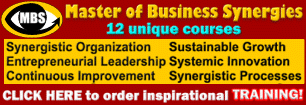|
Effective Conflict Resolution The Art, Science, and Practice |
|
by Vadim Kotelnikov & Ten3 East-West
"No one so thoroughly appreciates the value of constructive criticism as the one who is giving it..." - Arthur Robinson
|
No-Lose Method - Turning Conflict Into Cooperation The No-lose Method produces a solution that brings mutual need satisfaction. It is acceptable to everyone, so nobody feels a loser. It is not easy to acquire competence in applying this method. Searching for a solution requires creative thinking: "we've got a problem to solve, so let's get creative". It is important that you not start the process with one fixed, preconceived solution or a number of alternative solutions. The important thing that you remain open to other solutions. The No-lose Method brings many benefits:
The No-lose Method for resolving conflict between people is just a special application of problem solving, involving six separate steps: identifying and defining the problem; generating alternative solutions; evaluating the alternative solutions; decision making; implementing the decision; and following up to evaluate the solution. Only those people directly involved in the conflict should be included in the problem-solving. NLP Solutions: Dealing with Rude and Unfair Clients First of all, you need to set aside sufficient time for solving the problem and give the client your attention. Also keep in mind that you don't have to be rude or defensive even if you feel that your client is unfair. Doing this would communicate that it is the client who is the problem, not that the client has a problem that needs to be solved. Some clients are rude just because they may believe that it is the only choice they have and they are used to getting their way in this manner. In this case, you have an opportunity to educate, to teach them new choices, and also discover new ways for keeping such clients. You cannot change the past, but you can change the way it's remembered. Similarly, you cannot change the future, but you can influence it based on what you do now, in the present. If you wish to salvage the relationship, try to find a solution in cooperation with your client. Rather than coming up with your all your own scenarios that don't match what your client wants, ask him or her: "What is it that we can do right now to make this right?" Such a question will help you to stop your client focusing on the problem and start focusing on finding a solution. It also communicates them that you are also attempting to solve the problem. Once you get a response, you have a point to start negotiating from. Resolving Conflicts Between Business Partners If you succeeded in building mutual trust with your business partner, it will serve as a strong foundation that will free you to respond together to the unexpected, which is essential for mutual creativity in conflict resolution. Business is too complex to expect ready agreement on all issues, and trust, thus, does not imply easy harmony. "However, in a trusting relationship conflicts motivate you to probe for deeper understanding and search for constructive solutions. Trust creates good will, which sustains the relationship when one firm does something the other dislikes. Having trust gives you confidence in a relationship and makes it easier to build even more."1
|
Bibliography:
-
"Trusted Partners", Jordan D. Lewis, 1999



